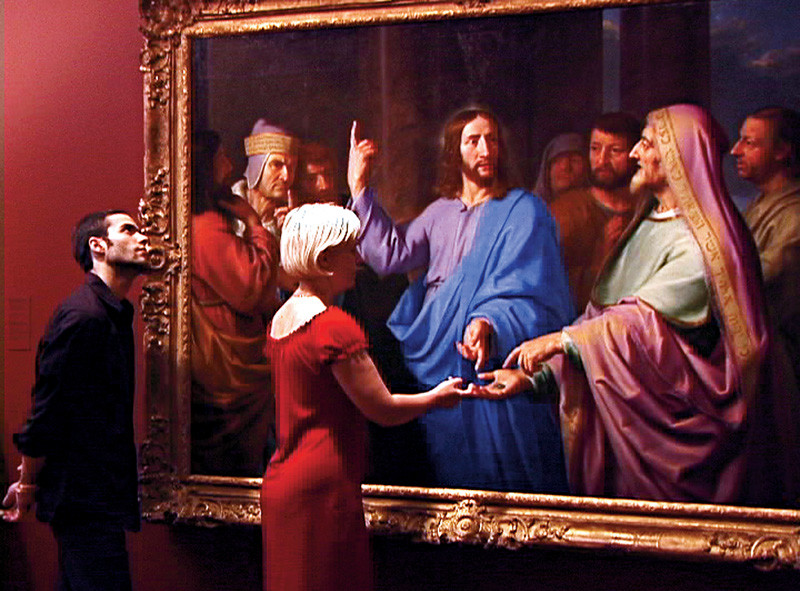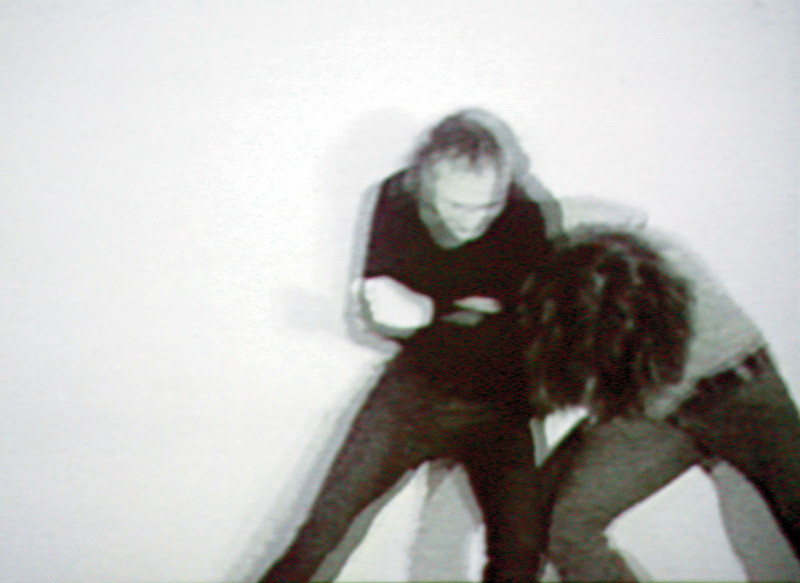[Fall 2004]
March 4–May 22, 2004
Dazibao, Montréal
Performance and Photography: POINT & SHOOT is a three-part exhibition project curated by Michèle Thériault and France Choinière that examines the photograph as performance prop, subject, and object, and the photographic process as performative act, witness, and documentarian.
Shown at Dazibao in March, April, and May 2004, this project was composed of two consecutive group exhibitions and a day-long performance event, La lumière comme surmoi, organized in collaboration with Sylvie Cotton. Examining the intense relationship between performance and photography, these exhibitions show us how photography remembers, and how this memory can be influenced and manipulated by the artists who direct the camera.
Although not intended as a historical representation of photographic performance practices, Performance and Photography: POINT, the first of the two consecutive exhibitions, demonstrates a history of practices tied to clear-cut constructions and purist demonstrations of performativity. “The performance works carried out three or four decades ago seem now to be more action-oriented, with the photograph standing in only as document or ‘proof’ of the action.”1 Vito Acconci plays with the frame of Super-8 film in Three Frame Studies. In this trilogy, he literally competes for frame space by pushing and shoving his co-performer in a fight for frame dominance, celebrity, and the viewer’s attention, while focusing the viewer on the construction of the frame itself. Thériault and Choinière have gathered works from other art stars of the 1960s and 1970s – Max Dean, General Idea, Suzy Lake, Arnulf Rainer, and Paul Wong – all of whom use photography as a means to communicate performativity. Paul Wong pads himself into an elevator-like cell, bouncing off the walls, dancing, screaming, freaking out in true anarchistic punk form to the intensity of the Sex Pistols and Patti Smith. Broadcast via black-and-white video monitor, In Ten Sity (1979) thrashes identity around through Method performativity in a staged setting, creating a distance between artist and viewer so that he can be better examined in all of his construction. Likewise, Suzy Lake’s Co-Ed Magazine (1973–98) features five constructed black-and-white portraits of Lake looking off camera as though she were being interviewed in a kitchen. The images are eerie because of Lake’s whiteout face and her crisp yuppie clothes, none of which age in any of the images – only the hairdos change from Streisand bouffant to Friends hair-flip.
Performativity becomes more complex and layered in the second exhibition, Performance and Photography: SHOOT. Bringing us works by Adad Hannah, André Lemke, John Marriott, Shelley Niro, Judy Radul, Ana Rewakowicz, Alana Riley, Chih-Chien Wang, and Chris Wildrick, this exhibition delves deeper into contextual construction and blurs the boundaries between photographic documentation and performative practice. In Alana Riley’s series, Support System, Riley lies underneath a stranger and supports their combined weight while taking their head-to-toe picture with a black shutter cord that extends outside of the frame. Floating in a white background, these portraits have been hung vertically so that they become standing portraits, and it appears as though Riley and the stranger could slip out of the picture at any moment. Adad Hannah’s video projection Stills features people standing statue-still while viewing paintings in a museum context. A man prays in classic Renaissance pose in front of what we imagine to be a painting, wearing a casual dress-shirt. Tears stain his cheeks: he is crying, yet his expression stays rigidly still, reflecting the constructed nature of painting, viewing, and the “moving” image.
Judy Radul’s piece Theatrical pushes the conceptual realm of the photograph in her use of the sidebar descriptive that accompanies the work. In the first black-and-white image, a man stands in a shopping-mall parking lot, his car trunk open, talking to a woman. The second image is the inside of a car trunk. The sidebar describes how Radul was stripped naked and transported in the trunk of a car from her home in Vancouver to the edge of the Fraser River with only a flash camera, but her final destination was ironically diverted to a multiplex suburb to discourage illegal dumping. This description acts as a conceptual photograph, filling in the subjective blanks and Radul’s intent, feeding the viewer’s voyeurism for the macabre and the possibility of tragedy.
Similarly, Karen Spencer uses performance and the act of storytelling as a means to stimulate a photographic outcome for the viewer in her piece, Facing the Lost, as part of La lumière comme surmoi. The experience of the everyday, of taking the metro, is transformed into the site for this piece. Taking headphones and a CD Walkman from the artist, the viewer is directed to the landing on the Sherbrooke Metro station that overlooks the parallel train tracks. On the CD, a soft female voice intimates rich details of a lush landscape and pointedly describes where the river and trees would be within the reality of the cement metro tunnel and platform. This virtual setting begins to take shape, the rush of the metro blends with the surge of the river on the soundtrack, and the viewer is lulled both by the soft tones of the narrator’s voice and the slow flow of trains coming and going. She quietly tells a story of death, loss, guilt, and tragedy in which a boy drowns while a woman watches helplessly. The viewer is caught between fiction and fact as the narrative is superimposed over the tracks – a boy could fall just as easily in front of a train as he did into the river – the helpless feeling of the woman manifests itself in the viewer watching from the landing above. The groan of the ticket turnstiles, the banality of the waiting passengers on the platform, and the constantly moving train underscore the rhythm of time moving forward, the feeling of helplessness for the woman and the drown boy, and the apathy of people standing by.
All of the pieces in this three-part project reference the photograph – the snap of a picture, the capture of a moment – photography acting as the deceptively honest memory of our culture that separates events into single frames to be kept or discarded, depending on the intent of the keeper of the frames. The documentary role of photography shifts the performative act, emphasizing moments within a performance as document-worthy – creating a hierarchy over other moments in the performance when other frames are discarded. Moments are chosen for aesthetic reasons – colour, light, movement – subjective artistic reasoning isolating frames and pushes them to the forefront of our collective memory, becoming our memory of the performance itself. But when the photographers flip the camera and point it at themselves or their practice, this cultural memory becomes apparently constructed, obvious in its exposure of the photographer as performance artist and/or documentarian, and the viewer is transformed into an unsuspecting accomplice.



